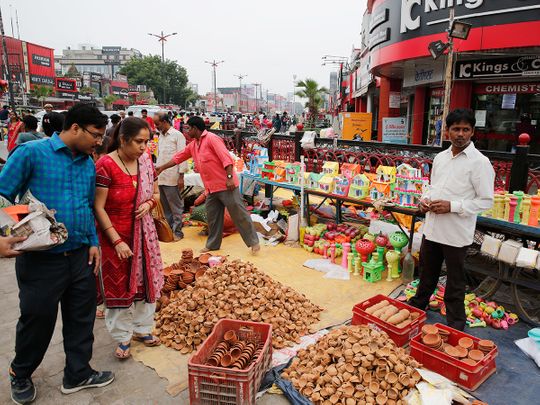
Mumbai: India’s investment and consumption activity weakened in September, putting the economy on course for yet another quarter of sub-par growth.
The dial on a gauge measuring overall economic activity swung one notch into weaker territory, with seven of the eight high-frequency indicators compiled by Bloomberg News showing weakness and one ticking up slightly. That caps a quarter of subdued activity, and is bound to disappoint investors looking for signs of a recovery after growth in national output slipped to a six-year low of 5 per cent in the April-June period.
The dashboard measures “animal spirits,” a term coined by British economist John Maynard Keynes to refer to investors’ confidence in taking action. It uses the three-month weighted average to smooth out volatility in the single-month numbers.
Businesses are pinning their hopes on a revival in consumer demand during the upcoming Diwali religious festival in India. The central bank has already cut interest rates five times in a row to spur spending, while the government has taken a series of fiscal steps to boost growth, including a $20 billion cut to corporate taxes.
Here are the details of the dashboard:
Business activity
India’s dominant services industry contracted in September, with the index measuring activity in the sector dropping sharply to 48.7 in September, its lowest reading since February 2018. Business confidence sank to its lowest in 31 months, according to an IHS Markit survey of private sector companies.
The manufacturing sector performed a tad better. The purchasing managers’ index was unchanged at 51.4 in September from the previous month. Together with the slump in services, that dragged the composite output index to 49.8 in September from 52.6 in August. A reading below 50 signifies contraction.
Inflation pressures remain subdued against the backdrop of weak demand. In the services sector, input costs rose at the slowest pace in more than two-and-a-half years, while in manufacturing, input cost inflation was close to its lowest in almost a decade.
Exports
Exports in September fell 6.6 per cent from a year ago to $26 billion, while imports fell at a faster pace — a reflection of weak domestic demand — helping to narrow the trade deficit to a seven-month low.
“The contraction in non-oil merchandise exports in four of the six months of the fiscal year 2020 is disappointing,” said Aditi Nayar, principal economist at ICRA Ltd. in Gurgaon, near New Delhi. “Gems and jewellery, textiles and engineering goods drove the year-on-year decline in non-oil merchandise exports in September.”
Consumer activity
Consumption, the backbone in the Indian economy, remained subdued.
Sales of cars in India plunged 33 per cent in September from a year earlier, down for an 11th consecutive month, according to data released by the Society of Indian Automobile Manufacturers.
In more bad news, sales growth of corner-store items from tea to toothpaste across India’s villages weakened to 5 per cent in the quarter ended September, compared with 20 per cent last year, according to a Nielsen report released last week. Expansion in rural areas dropped below urban levels for the first time, dragging the overall growth in sales to 7.3 per cent, less than half of what it was in the same quarter in 2018.
Subdued consumer demand meant companies were borrowing less from banks to invest. While total bank credit ticked up in September from the previous month to 97.7 trillion rupees, growth slowed from a year ago to 8.8 per cent at the end of September from 10.3 per cent at the end of August.
Financial conditions, as indicated by the Citi India index, also tightened in the month, another factor which might have weighed on lending.
Industrial Activity
Factory output contracted for the first time in more than two years in August, as a sharp fall in capital goods and consumer durables production weighed on activity.
It’s likely that industrial production might struggle more in coming months. The index of eight core infrastructure industries declined 0.5 per cent in August from a year ago, with production in five sectors, including electricity and cement, shrinking. The core infrastructure industries output constitutes 40 per cent of total industrial production. Both sets of data was released with a month’s lag.












